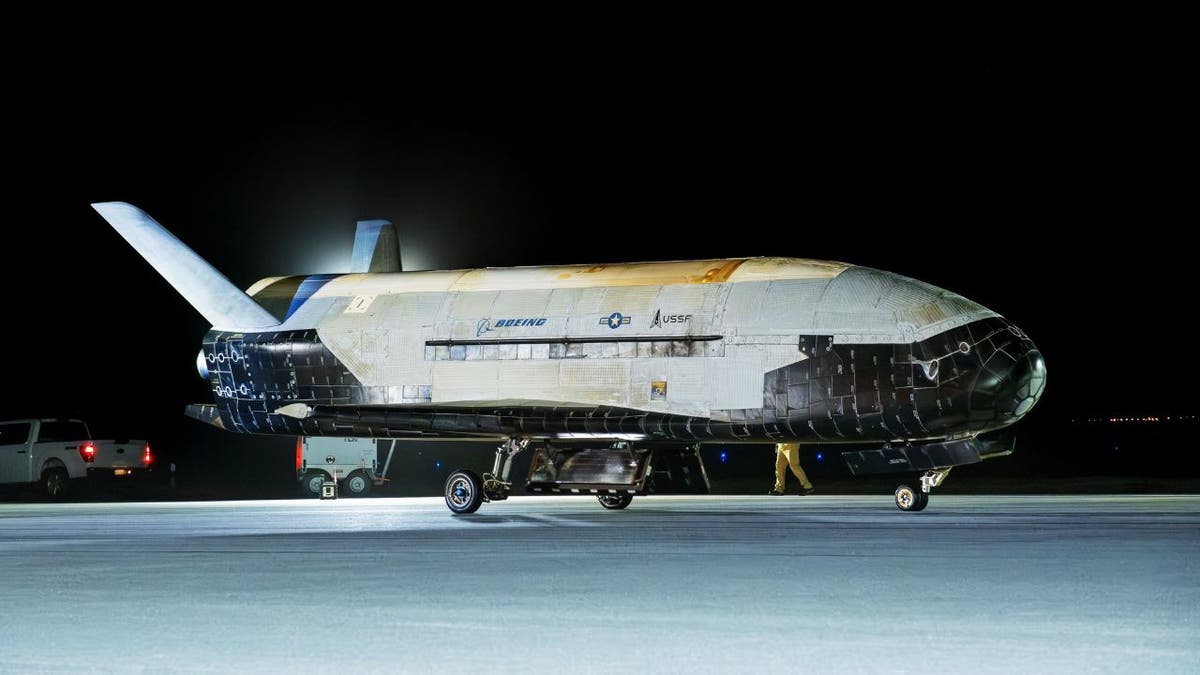
X-37B Space Plane Concludes Secretive 434-Day Mission, Pushing Boundaries of Space Technology
The United States Space Force’s enigmatic X-37B space plane concluded its seventh mission, landing at Vandenberg Space Force Base in California after an impressive 434 days in orbit. This unmanned, Boeing-manufactured aircraft’s return marks the end of a mission filled with classified tests and experiments, further solidifying its role as a critical asset in advancing space technology and capabilities.
The X-37B, launched from NASA’s Kennedy Space Center in Florida aboard a SpaceX Falcon Heavy rocket in 2023, is a reusable, solar-powered spacecraft operated remotely. While the exact nature of its payloads and activities remains largely shrouded in secrecy, the Space Force has offered some glimpses into the objectives and achievements of Mission 7.
One of the key highlights of this mission was the exploration of a highly elliptical orbit and the demonstration of the aircraft’s robust maneuverability. This involved utilizing a technique called aerobraking, where the spacecraft uses the Earth’s atmosphere to efficiently change its orbit while minimizing fuel consumption. This innovative approach to orbital maneuvering offers significant advantages in terms of cost-effectiveness and mission longevity.
Furthermore, Mission 7 focused on testing space domain awareness technology experiments. These experiments are designed to enhance the United States Space Force’s understanding and monitoring of the space environment. As the number of satellites and space debris continues to grow, the ability to accurately track and identify objects in orbit becomes increasingly crucial for ensuring the safety and security of space assets.
The Space Force emphasized that Mission 7 successfully completed its test and experimentation objectives, including aerobraking to a low Earth orbit, before initiating its deorbit and landing procedures. The successful execution of these maneuvers underscores the X-37B’s versatility and adaptability in various orbital regimes.
Gen. Chance Saltzman, chief of space operations at Space Force, highlighted the significance of Mission 7 in pushing the boundaries of novel space operations. The successful aerobraking maneuver, in particular, demonstrates the Space Force’s commitment to innovation and responsible space exploration.
Lt. Col. Blaine Stewart, the X-37B program director, echoed this sentiment, stating that the mission represents a significant milestone in the ongoing development of the agency’s dynamic mission capability. The operation in a new orbital regime, the novel aerobraking maneuver, and the testing of space domain awareness experiments have together written a new chapter in the X-37B program.
The Space Force has released a few images of the X-37B after its landing, providing a rare glimpse into the secretive program. One image shows personnel in protective suits approaching the space plane, emphasizing the sensitive nature of the technology and materials involved.
The X-37B program has a long and storied history, with each mission pushing the boundaries of what is possible in space. The extended duration of these missions, combined with the reusable nature of the spacecraft, makes the X-37B a valuable asset for conducting long-term experiments and testing new technologies in the space environment.
While the secrecy surrounding the X-37B program has fueled speculation and intrigue, the underlying purpose is clear: to advance the United States’ capabilities in space and maintain its leadership in this critical domain. The data and knowledge gained from these missions contribute to the development of new technologies, improved space domain awareness, and enhanced national security.
The X-37B’s ability to operate in different orbital regimes, perform complex maneuvers, and conduct long-duration experiments makes it a versatile platform for a wide range of missions. Its reusable design also makes it a cost-effective solution for accessing space and conducting research.
As space becomes increasingly contested and congested, the X-37B’s role in maintaining space superiority and protecting U.S. assets in orbit will become even more important. The Space Force’s continued investment in this program demonstrates its commitment to ensuring the nation’s security and prosperity in the space domain.
The X-37B’s latest mission is a testament to the ingenuity and dedication of the men and women of the United States Space Force and its industry partners. Their efforts are pushing the boundaries of space technology and paving the way for future advancements that will benefit all of humanity.
The conclusion of Mission 7 marks the end of one chapter in the X-37B program, but it also signals the beginning of a new era of space exploration and innovation. As the Space Force continues to develop and refine its capabilities, the X-37B will undoubtedly play a crucial role in shaping the future of space operations.
The secretive nature of the X-37B program will likely continue to generate curiosity and speculation, but one thing is clear: this space plane is a vital asset in the United States’ efforts to maintain its leadership in space and ensure its national security. The X-37B’s successful completion of Mission 7 is a reminder of the importance of investing in space technology and supporting the dedicated professionals who are pushing the boundaries of what is possible.
